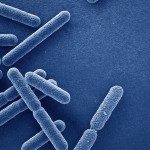About
The bacterial envelope is one of the oldest and most essential cellular components, being involved in key housekeeping functions, such as physical integrity, cell division, motility, substrate uptake and secretion, and cell-cell communication. It is also a key factor contributing to bacterial pathogenicity, playing roles in bacterial adherence and biofilm formation, virulence factor secretion and resistance to antimicrobials. Yet, bacteria show substantial differences in their cell envelope architectures, among which the most dramatic one is the fact of having one membrane (Gram-positive or monoderm) or two membranes (Gram-negative or diderm). When, how and why such transition between monoderm and diderm cell envelopes occurred is one of the major unanswered questions in Evolutionary Biology. Moreover, a wide diversity of cell envelopes exists across understudied branches of the bacterial tree with no or very little information.
The Negativicutes and the Halanaerobiales are two poorly known lineages of bacteria that, despite belonging phylogenetically to the Firmicutes (low G+C gram positives), possess outer membranes with lipopolysaccharide. Through phylogenomic analysis we have recently shown that the cell envelopes of these two atypical diderm Firmicutes represent ancestral cellular structures that would have been lost in the majority of present-day Firmicutes, giving rise to their gram positive phenotype. This result represent an important change of paradigm, illustrating an example of evolution through simplification. It also opens up numerous questions:
-How did the outer membrane of diderm Firmicutes originate and how is it related to the other diderm bacterial phyla?
-What are the characteristics of the outer membrane of Negativicutes and Halanaerobiales, and what can we learn on the diversity and evolution of fundamental processes linked to the biogenesis and function of the bacterial cell envelope?
-How was the outer membrane lost in monoderm Firmicutes and what impact did it have on their cell envelopes?
With the Fir-OM project, we aim at answering these questions though a pioneering investigation of the cell envelopes of Negativicutes and the Halanaerobiales. We will apply an original combination of experimental and in silico approaches. We will expand the genomic coverage for both lineages through targeted sequencing of representative members. We will characterize their cell envelopes by proteomics and microscopy. The role of a number of candidate components in cell envelope biogenesis and function will be investigated through development of genetic tools. These data will be integrated into a detailed phylogenomic analysis to compare the characteristics of cell envelope components between diderm firmcutes and their closely related monoderm lineages.
This project will pioneer a novel research line on two largely understudied bacterial clades, one of which, the Negativicutes, contains members that are important components of the human microbiome. We will provide data on a novel type of bacterial cell envelope, sensibly expanding knowledge on the diversity and evolution of one of the oldest cellular components.




